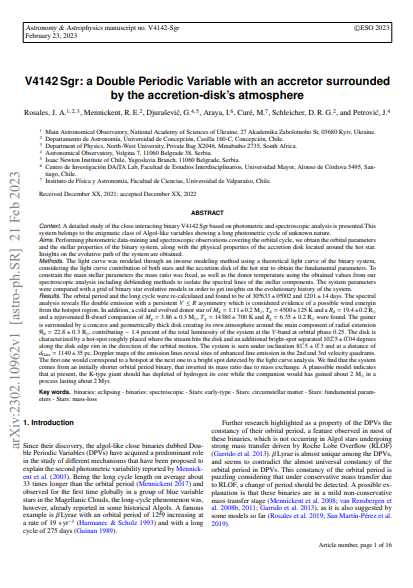V4142 Sgr: Double periodic variable with an accretor surrounded by the accretion disk's atmosphere

Fecha
2023-02-10Autor
Rosales, JA.
Mennickent, RE.
Djurasevic, G.
Araya, I. [Univ Mayor, Fac Estudios Interdisciplinarios, Ctr Invest DAiTA Lab, Chile]
Cure, M.
Schleicher, DRG.
Petrovic, J.
Ubicación geográfica
Notas
HERRAMIENTAS
Acceda a títulos restringidos
¿Cómo descargar?Resumen
Context. A detailed study of the close interacting binary V4142 Sgr, based on photometric and spectroscopic analyses, indicates that this system belongs to the enigmatic class of Algol-like variables exhibiting a long photometric cycle of an unknown nature.Aims. By performing photometric data-mining and spectroscopic observations covering the orbital cycle, we obtained the orbital parameters and the stellar properties of the binary system, along with the physical properties of the accretion disk located around the hot star. In addition, we gained insights into the evolutive path of the system.Methods. We modeled the light curve through an inverse method, using a theoretical light curve of the binary system that considers the light curve contribution of both stars and the accretion disk of the hot star to obtain the fundamental parameters. To constrain the main stellar parameters, the mass ratio was fixed in addition to the donor temperature, using the obtained values from our spectroscopic analysis, which includes deblending methods to isolate the spectral lines of the stellar components. The system parameters were compared with a grid of binary star evolutive models in order to gain insights into the evolutionary history of the system.Results. The orbital period and the long cycle were re-calculated, with the following result: 30(d).633 +/- 0(d).002 and 1201 +/- 14 days. The spectral analysis reveals H alpha double emission with a persistent V <= R asymmetry, which is considered evidence of a possible wind emerging from the hotspot region. In addition, a cold and evolved donor star of M-d = 1.11 +/- 0.2 M-?, T-d = 4500 +/- 125 K and a R-d = 19.4 +/- 0.2 R-? as well as a rejuvenated B-dwarf companion of M-g = 3.86 +/- 0.3 M-?, T-g = 14 380 +/- 700 K, and R-g = 6.35 +/- 0.2 R-? were found. The gainer is surrounded by a concave and geometrically thick disk, creating its own atmosphere around the main component of a radial extension, R-d = 22.8 +/- 0.3 R-?, contributing similar to 1.4 percent of the total luminosity of the system at the V-band at orbital phase 0.25. The disk is characterized by a hot-spot roughly placed where the stream hits the disk and an additional bright-spot separated 102.(?)5 +/- 0.(?)04 degrees along the disk edge rim in the direction of the orbital motion. The system is seen under an inclination of 81.(?)5 +/- 0.(?)3 and at a distance of d(Gaia) = 1140 +/- 35 pc. Doppler maps of the emission lines reveal sites of enhanced line emission in the second and third velocity quadrants. The former would correspond to a hotspot and the latter to a bright spot detected by the light curve analysis. We find that the system comes from an initially shorter orbital period binary that inverted its mass ratio due to mass exchange. A plausible model scenario indicates that, at present, the K-type giant should have been depleted of hydrogen in its core, while the companion would have gained about 2 M-? through a process lasting about 2 Myr.
URI
https://repositorio.umayor.cl/xmlui/handle/sibum/9491https://arxiv.org/pdf/2302.10962.pdf
https://www.aanda.org/articles/aa/pdf/2023/02/aa44046-22.pdf
https://doi.org/10.1051/0004-6361/202244046
Coleccion/es a la/s que pertenece:
Si usted es autor(a) de este documento y NO desea que su publicación tenga acceso público en este repositorio, por favor complete el formulario aquí.